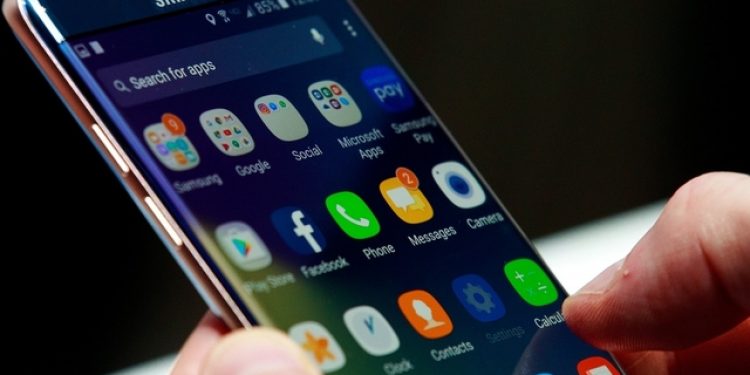Washington: Technology firms are taking aim at the opioid crisis and related health problems with a new class of treatments — digital therapeutics — delivered by smartphone.
These new treatments, backed by medical research and offered by prescription, are seen as potential ways to supplement, and in some cases replace, pharmaceuticals to treat addiction and an array of other mental and physical health issues.
Smartphone technology may be well-suited to behavioral therapy for addiction, depression and other disorders by making treatment more accessible and trackable by medical professionals, researchers say.
“Digital therapeutics are validated scientific treatments delivered in the form of software, which can increase access and provide an immediacy,” said Yuri Maricich, head of the clinical and regulatory team at Pear Therapeutics.
The company has received approval in the United States for apps to treat opioid addiction and other kinds of substance abuse.
“It’s the same level of rigor (as pharmaceuticals) in terms of how the products are manufactured. We’ve run randomized clinic trials to make sure it produces the desired outcome and that it is safe,” Maricich said.
In January, Pear launched in coordination with Novartis unit Sandoz the reSET-O prescription digital therapeutic 12-week cognitive behavioral therapy to treat opioid addiction after receiving approval by the US Food and Drug Administration.
It is offered with the commonly used medication buprenorphine for adults under the care of a therapist.
The app includes a dashboard that allows medical teams to monitor a patient’s progress and offer reminders and training. The patient follows on-screen prompts by answering quiz questions, reporting medication usage and reporting substance use, cravings and triggers.
The goal of these apps is to ‘reprogram’ the brain’s rewards system once it has been distorted by addictive substances.
“With these technologies, you disrupt that behavior chain and learn new skills to make lifestyle changes to stop self-defeating patterns,” said Lisa Marsch, director of the Center for Technology and Behavioral Health at Dartmouth University, which has conducted trials with Pear and other digital therapeutics firms.
Marsch said research has been ongoing on digital therapies for decades but that the growth in smartphones has made it easier to deliver such care.
“People can use it 24/7 as a clinician in their pocket,” she said.
The impact on substance addiction is notable. Forty percent of patients who used the first Pear application, reSET, along with standard therapy abstained from alcohol, cocaine, marijuana and other substances over three months compared with 17.6 percent for those receiving standard therapy alone.
For reSET-O, 82.4 percent of those using the app remained in therapy — the so-called “retention rate” — through 12 weeks, compared with 68.4 percent for those not using the app.
Shawn Ryan, a University of Cincinnati professor of medicine and president of the Brightview addiction clinic, said one advantage of digital treatments is that therapists can better track patient progress.
“The digital platforms have figured out how to deliver that treatment and track them,” he said.
“There’s so much more data we get by evaluating this through digital platforms.” Additionally, digital therapies can be delivered remotely in areas where medical care is scarce.
“In many parts of the country there are not enough professionals so the alternative is nothing,” Ryan said.
Opioid addiction has ravaged many US communities over the past decade.
An estimated 47,000 people died in the United States from opioid overdoses in 2017, according to the Centers for Disease Control, and 1.7 million people were suffering from addiction to painkillers like OxyContin.
Investments in digital therapeutics startups nearly doubled in 2018 to some $811 million, according to the research firm CB Insights, with $191 million tallied so far in 2019.
“We are seeing strong interest from pharmaceutical companies,” said CB Insights analyst Ja Lee.
These treatments “present a novel opportunity for patients to manage chronic diseases (and) are gaining more interest as new types of treatments enter the market, a CB Insights report said.
Juniper Research meanwhile predicts the market for digital therapeutics will top $32 billion in revenues in 2024, up from an estimated $2.2 billion in 2019, with diabetes and weight loss the biggest growth segments.
Among companies in the sector, San Francisco-based Omada is using an app offering coaching for diabetes care;, and British-based SilverCloud Health offers apps for anxiety, depression and other mental health treatments.
The treatments may include online chats, patient checklists and in some cases monitoring of data from linked devices such as sensors, wearables or insulin pumps.
Holding back the market, some analysts say, is confusion over tested digital therapies and the vast number of “wellness” applications that are freely available for conditions like insomnia and anxiety.
James Madara, chief executive of the American Medical Association, warned in 2016 of the difficulties of “separating the digital snake oil from the useful” digital tools, without specifically mentioning digital therapeutics.
(AFP)






































